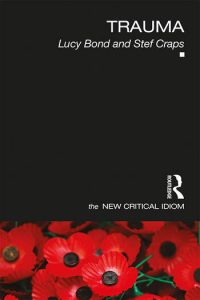Trauma by Lucy Bond and Stef Craps. London: New Critical Idiom, Routledge, 2019, 173 pp.
Review by Lewis Kirshner, MD
In lieu of an abstract, here is a brief excerpt of the content:

This concise and informative treatment of the history and changing uses of the term “trauma” covers a broad range of topics, from clinical to popular social contexts. While the book’s intended audience encompasses mainly literary and cultural scholars, students in mental health disciplines and social sciences can find much here of relevance for their own fields. Trauma, as the Bond and Craps observe, has become a thriving subject of political and social discourse, applied widely and sometimes loosely to an enormous variety of situations. As such, it has expanded our understanding of forms of human suffering, both the psychological effects of personal and social violence, and the more subtle influence of global events like environmental and technological changes on our lives. At the same time, the prevalent focus on trauma risks becoming a master narrative that obscures important political and economic issues. The authors tread a careful path between an appreciative, receptive approach to the expanding applications of the concept of trauma and a critical skepticism about its relevance.
Chapter One introduces the history of the trauma concept with the 19th century’s concern with physical injuries resulting from the changed conditions of modern industrial life. Puzzling medical complaints following railway and work accidents created legal and financial problems with which European societies increasingly had to wrestle. Not the least of these was the status of non-organic afflictions that raised medical suspicions of malingering, character weakness, and the validity of diagnoses like hysteria or neurasthenia. Freud, of course, adapted the term trauma to the impact of life events on similar patients who consulted him for various mental and behavioral complaints. Under the influence of the French neurologists Charcot and Bernheim, he redefined hysteria as a post-traumatic state characterized by problems of memory of unassimilable experiences, perhaps with an organic basis. In the place of recollection, the patients displayed sometimes dramatic physical and emotional symptoms, whose origins could be reconstructed <…>
American Imago, 77(4), 800-808, Winter 2020.
Link to Online Publication [fulltext can be requested from the library].
About the Author
Lewis A. Kirshner, MD, is a Corresponding Member of the Faculty at Harvard Medical School and a Training and Supervising Analyst Emeritus at the Boston Psychoanalytic Society and Institute. He is currently living in Amsterdam and has been a visiting professor in Lyon, France, and a Fulbright senior fellow in Ghent, Belgium. His numerous publications
have treated developments in French psychoanalysis and the work of Lacan, Winnicott, and Ferenczi. He is the author of Having A Life: Self Pathology after Lacan (2004), Between Winnicott and Lacan: A Clinical Engagement (2011), and Intersubjectivity in Psychoanalysis: A Model for Theory and Practice (2017).
Previous Posts:
Cuneyt Iscan, MD (2021). Large-Group Psychology: Racism, Societal Divisions, Narcissistic Leaders, and Who We Are Now, by Vamik D. Volkan, Phoenix Publishing House Ltd, Oxfordshire, UK, 2020, 139 pp. American Journal of Psychoanalysis, 81: 244–248.
José Saporta, MD (2021). Psychoanalysis and Our Cultural Crisis. Subject, Action, & Society: Psychoanalytical Studies and Practices, 1(1): 91-109.
Elsa Ronningstam, PhD, Mark Goldblatt, MD, Mark Schechter, MD, Benjamin Herbstman, MD (2021). Facing a patient’s suicide—The impact on therapists’ personal and professional identity. Practice Innovations, 6(2), 89–106.
Anton O. Kris, MD (2021). Love Is the Great Educator: Response to Richard Frank and Mel Bornstein. Psychoanalytic Inquiry, 41(4-5), 289-291.
Alex Hoffer, MD (2020). Psychoanalysis as a Two-Person Meditation: Free Association, Meditation, and Bion. The American Journal of Psychoanalysis, 80(3): 331–341.
Nancy J. Chodorow, PhD. (2021). Women Mothers Daughters: The Reproduction of Mothering After Forty Years. In Bueskens, P., ed. Nancy Chodorow and The Reproduction of Mothering: Forty Years On. Palgrave, pp. 49-80.
Anthony D. Bram, PhD. (2021). Introduction – In-Session Use of Digital Material in Child Psychoanalysis and Psychotherapy. The Psychoanalytic Study of the Child, 74(1): 304-307.
Steven H. Cooper, PhD. (2021). Toward an Ethic of Play in Psychoanalysis. The Psychoanalytic Quarterly, 90:3, 373-397.
Diane O’Donoghue, PhD. (2021). Amnesias of a Freudian Kind. Part One. American Imago 78(1), 55-77.
Charles Levin, PhD and Dawn Skorczewski, PhD. (2020).The Poetics of Boundary Violation: Anne Sexton and Her Psychiatrist. Psychoanalytic Dialogues, 30(2), 206-221.
Andrea Celenza, PhD (2020). Embodiment and the Perversion of Desire. The Psychoanalytic Quarterly, 89(3), 369-398.
Steven H. Cooper, PhD (2021). Donald Winnicott and Stephen Mitchell’s Developmental Tilt Hypothesis Reconsidered. Psychoanalytic Dialogues, 31(3), 355-370.
Elsa Ronningstam, PhD (2021). Cultural Function and Psychological Transformation of Silence in Psychoanalysis and Psychotherapy. In Dimitrijevic, A. and Buchholz, M.B., eds. (2021). Silence and Silencing in Psychoanalysis: Cultural, Clinical, and Research Perspectives. Routledge, pp. 105-127.
Paola M. Contreras, PsyD (2021). The Magical and the My-Person in Psychoanalysis During the Covid Pandemic. Journal of the American Psychoanalytic Association, 68(6): 1113-1126. Open Access, DOI: 10.1177/0003065120981733
Click here to see a full archive of featured papers. All articles can be requested from the library.

